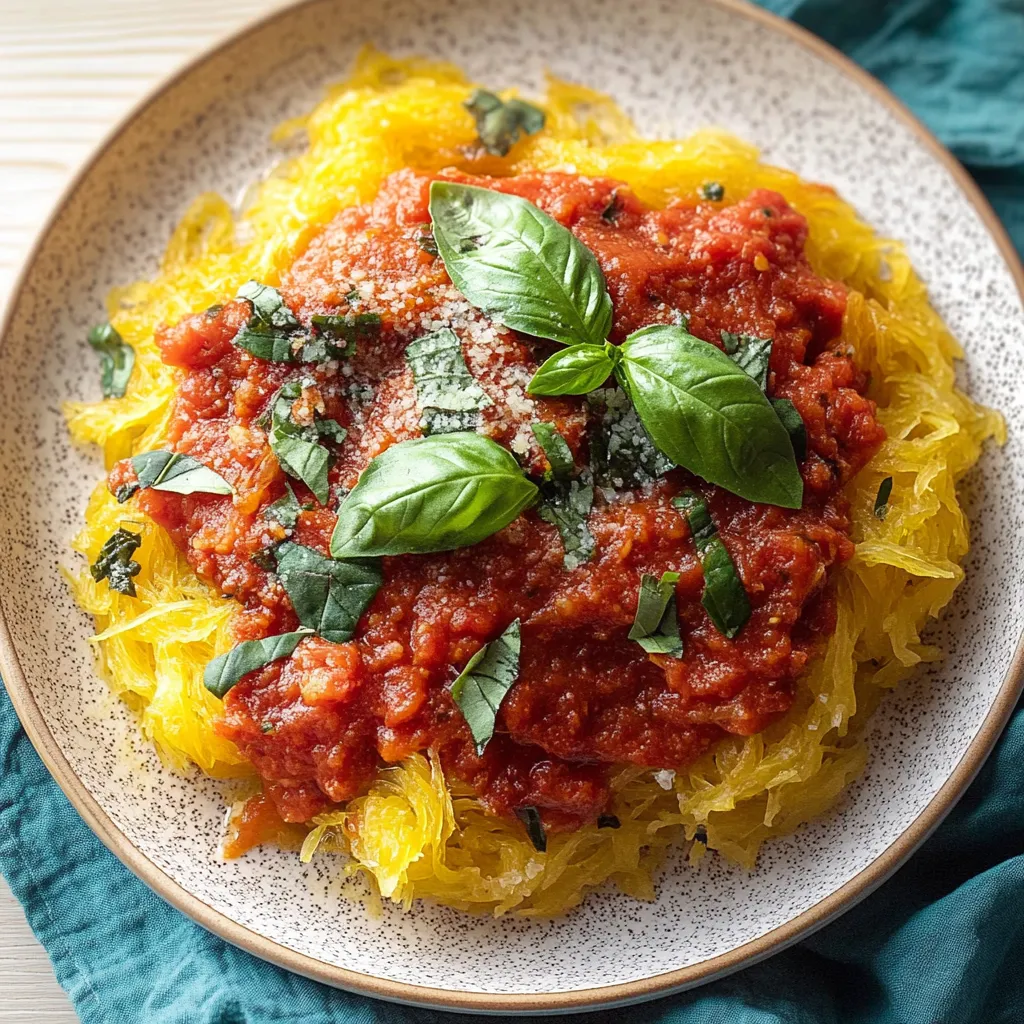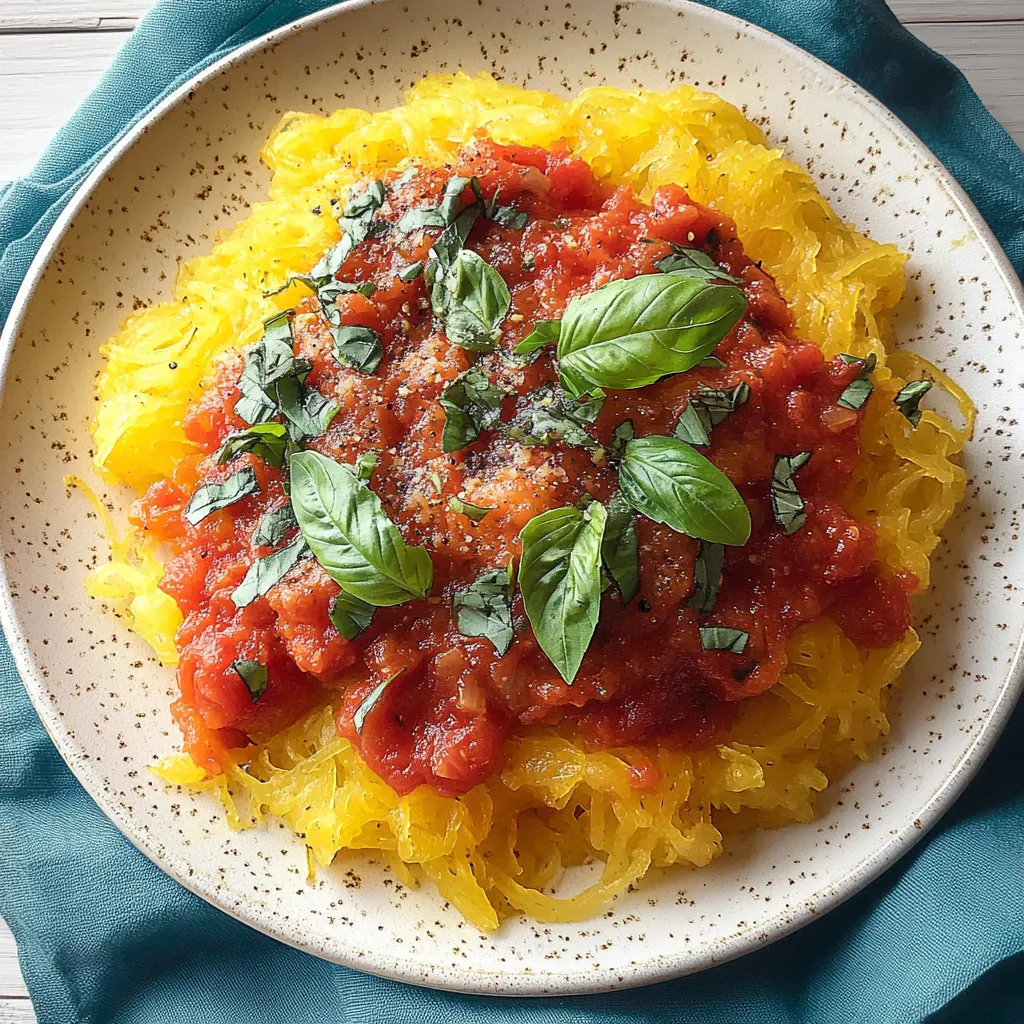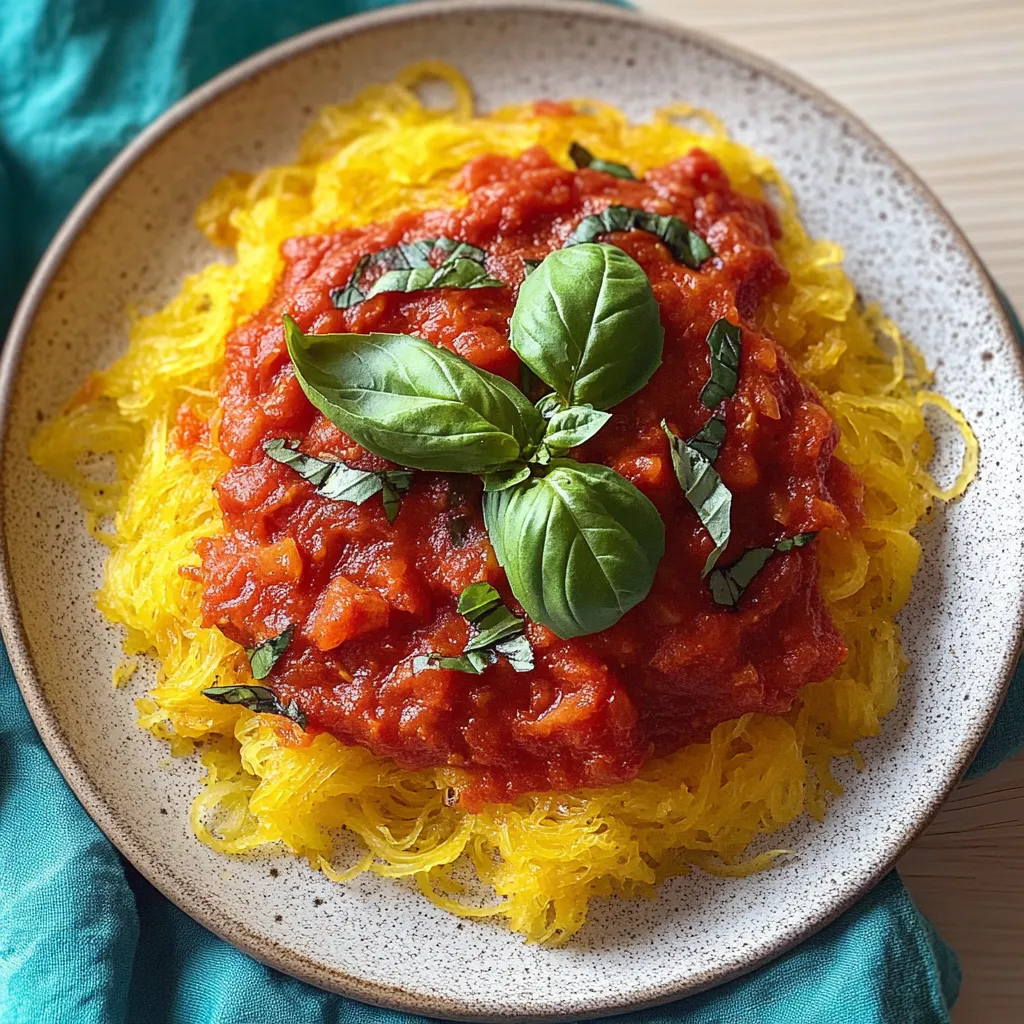 Save
Save
Spaghetti squash marinara delivers all the comfort of traditional pasta without the carbs. This wholesome dish features tender strands of roasted squash topped with rich, garlicky marinara sauce that soaks into every bite. The natural sweetness of the squash pairs beautifully with the savory tomato sauce, creating a satisfying meal that leaves you feeling nourished rather than weighed down. I discovered this gem of a recipe when searching for lighter dinner options and was genuinely surprised by how filling and delicious a vegetable-based "pasta" could be.
I made this for my family one skeptical Sunday evening, expecting complaints about missing "real pasta." Instead, everyone went back for seconds, asking how squash could possibly taste this good. My teenage daughter even requested it for her birthday dinner last year – a true testament to its deliciousness! The way the tender squash strands hold the rich sauce creates a truly satisfying eating experience.
Nature's Ingredients
- Spaghetti Squash: This magical vegetable naturally forms spaghetti-like strands when cooked, offering a mild, slightly sweet flavor that pairs perfectly with robust sauces. Choose one that feels heavy for its size with firm, unblemished skin for the freshest quality.
- Extra Virgin Olive Oil: Adds richness and helps the squash caramelize beautifully during roasting. The fruity notes enhance both the squash and sauce, so use the best quality you can afford.
- Fresh Garlic: Creates an aromatic foundation for the marinara sauce that infuses the entire dish. Look for firm bulbs with tight skin and avoid any with green sprouts for the cleanest flavor.
- Crushed Tomatoes: Provides the perfect texture for a homemade marinara that clings to the squash strands. San Marzano varieties offer exceptional sweetness and acidity balance if you can find them.
- Italian Seasoning: This convenient blend typically includes oregano, basil, thyme, and rosemary, adding complex herbal notes to the sauce without requiring multiple spice jars.
- Fresh Basil: Brightens the entire dish with its aromatic qualities. Choose bunches with vibrant green leaves and no black spots for the freshest flavor.
- Parmesan Cheese: Adds savory depth and creamy texture contrast. Look for authentic Parmigiano Reggiano that's been aged at least 24 months for the most complex flavor profile.
Cooking Method
- Prepare The Squash:
- Begin by preheating your oven to 400°F – this temperature creates the perfect environment for the squash to soften while developing subtle caramelization. Using a sharp chef's knife, carefully cut the squash lengthwise from stem to end. The tough exterior requires firm pressure, so take your time and maintain control of the knife. Once halved, use a sturdy spoon to scoop out the seeds and stringy center, just as you would with a pumpkin. Drizzle the exposed flesh generously with olive oil and season with salt and pepper, ensuring you get into all the nooks for even flavor distribution.
- Roast To Perfection:
- Place the prepared squash halves cut-side down on a parchment-lined baking sheet. This position allows steam to collect inside the cavity, helping the squash cook evenly while the cut surface caramelizes against the hot pan. Roast for 35-40 minutes, though cooking time may vary depending on the size of your squash. You'll know it's done when the flesh easily yields to the pressure of a fork and the skin has slightly softened. The natural sugars in the squash will have concentrated, enhancing its subtle sweetness.
- Create The Marinara:
- While the squash works its magic in the oven, prepare your sauce by heating olive oil in a deep saucepan over medium heat. Add minced garlic and finely chopped onion (if using) to the warm oil, sautéing until translucent and fragrant but not browned. This aromatic base will infuse the entire sauce with depth. Pour in the crushed tomatoes along with Italian seasoning, salt, and freshly ground pepper. Allow this mixture to simmer gently for 15-20 minutes, stirring occasionally to prevent sticking. The slow cooking process allows the flavors to meld together beautifully.
- Transform Into Strands:
- Once your squash has cooled enough to handle (but is still warm), the magic happens. Take a fork and gently scrape the flesh from one end to the other. You'll be amazed as it naturally separates into spaghetti-like strands! The texture should be tender but still have a slight bite, similar to al dente pasta. Continue until you've removed all the flesh, leaving just the empty skin behind. Fluff the strands gently with your fork to separate them and release any excess moisture.
 Save
Save
I discovered the scoring technique after nearly losing a finger trying to wrestle with a particularly stubborn squash. My grandmother later showed me how she'd always score squash and pumpkins before cutting – wisdom passed down through generations of home cooks. My family now enjoys spaghetti squash regularly through fall and winter. My husband, originally a pasta purist, now requests this version specifically for its flavor and how much better he feels after eating it compared to traditional pasta.
Perfect Pairings
This versatile dish welcomes countless accompaniments. For a complete meal, serve alongside a simple green salad with a light vinaigrette that won't compete with the marinara flavors. Garlic bread made with whole grain bread provides a satisfying contrast of textures while soaking up extra sauce. For protein, grilled chicken or turkey meatballs complement the lightness of the squash perfectly.
Consider topping your finished dish with a sprinkle of toasted pine nuts for an unexpected crunch, or a handful of fresh arugula that wilts slightly from the heat of the sauce, adding peppery notes. For casual gatherings, set up a toppings bar with different cheeses, fresh herbs, and roasted vegetables, allowing guests to customize their bowls.
Flavorful Changes
Mediterranean Inspiration: Transform the basic recipe by incorporating olives, capers, and a sprinkle of crumbled feta instead of Parmesan. The briny elements cut through the sweetness of the squash and add bold flavor dimensions. Fresh oregano makes an excellent finishing touch for this variation.
Autumn Harvest Version: Create a seasonal twist by adding roasted butternut squash cubes and crispy sage leaves to your marinara. A pinch of nutmeg and cinnamon adds warmth, while toasted walnuts provide textural contrast and complement the earthy flavors perfectly.
Asian Fusion Approach: Skip the marinara entirely and toss your squash strands with a sauce of ginger, garlic, soy sauce, and a touch of honey. Top with green onions, sesame seeds, and perhaps some crispy tofu for a completely different flavor profile that still showcases the versatile squash.
Fresh Preservation
Cooling Technique: Allow leftovers to cool completely before refrigerating to maintain texture integrity. Store the squash strands and sauce separately in airtight containers to prevent the squash from absorbing too much liquid and becoming soggy. This preparation allows for better texture when reheating and lets you adjust portions as needed.
Revitalizing Methods: When reheating, add a splash of water to the squash and heat gently in a covered pan to create steam that refreshes the strands. Heat the sauce separately until just bubbling, then combine. A fresh grating of Parmesan and new herbs brighten the leftover dish, making it taste nearly freshly made.
Freezing Wisdom: While the sauce freezes beautifully for up to three months, the squash is best enjoyed fresh. If you must freeze the squash strands, slightly undercook them initially, then freeze spread on a baking sheet before transferring to containers. This prevents clumping and allows you to take just what you need.
My journey with spaghetti squash began as a reluctant experiment during a health kick but quickly evolved into a genuine culinary preference. There's something deeply satisfying about transforming a humble vegetable into a dish that feels both nourishing and indulgent. I love watching first-timers' faces light up with surprise at how enjoyable vegetable "pasta" can be. The natural sweetness of well-roasted spaghetti squash creates a perfect canvas for robust sauces, and the nutritional benefits are just a happy bonus. Whether you're looking to reduce carbs, increase vegetables, or simply explore new flavors, this dish delivers satisfaction without compromise.
 Save
Save
Common Questions About Cooking
- → How do I know when spaghetti squash is done cooking?
- Spaghetti squash is done when the flesh easily pulls apart into strands with a fork. The squash should be tender but not mushy - typically after 35-40 minutes at 400°F.
- → Can I make this recipe ahead of time?
- Yes! You can roast the squash and prepare the sauce up to 3 days ahead. Store separately in the refrigerator and reheat when ready to serve.
- → Is this recipe vegan?
- The base recipe is vegetarian. To make it vegan, simply skip the Parmesan cheese or use a plant-based alternative.
- → What can I add to make this dish more filling?
- Try adding protein like Italian sausage, ground turkey, or chickpeas. You can also mix in sautéed vegetables like mushrooms, bell peppers, or spinach.
- → How do I cut a spaghetti squash safely?
- Use a sharp knife and cut lengthwise. If it's too hard, poke holes in the squash with a fork and microwave for 3-5 minutes first to soften it slightly before cutting.
